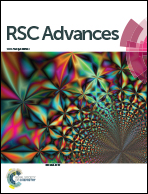NCN pincer palladium complexes based on 1,3-dipicolyl-3,4,5,6-tetrahydropyrimidin-2-ylidenes: synthesis, characterization and catalytic activities†
Abstract
The synthesis of novel pincer palladium complexes containing ring expanded six-membered N-heterocyclic carbenes (NHCs) via direct metallation of the precursors tetrahydropyrimidin-1-ium hexafluorophosphates in the presence of NaN(SiMe3)2 is presented. The structure has been characterized unambiguously by X-ray single crystal analysis. Catalytic activity investigation showed that the complexes catalyzed the Heck reaction of aryl bromides with acrylate/styrene efficiently when using Et3N as base and DMA as solvent.


 Please wait while we load your content...
Please wait while we load your content...